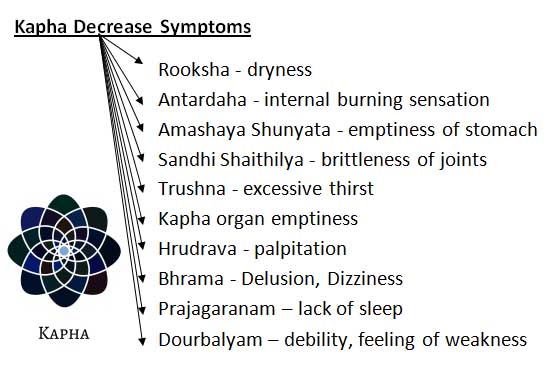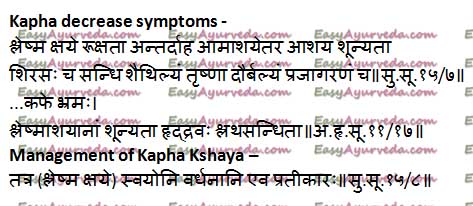Kapha Decrease Symptoms, Analysis, Treatment
Article by Dr Raghuram Y.S. MD (Ay) & Dr Manasa, B.A.M.S
Table of Contents
Introduction
When there is decrease in quality or quantity or functioning (or all) of any elements of the body (dosha, dhatus or malas), it will be called kshaya. Kshaya is a pathological state of any element.
Pathological decrease of a dosha is called dosha kshaya. It is a type of dosha vitiation, deviation from normalcy (dosha dushti). Among the triplet of dosha gati (status of doshas) mentioned in Ayurvedic texts i.e. kshaya (depletion or decrease), sthana (normalcy, balance) and vriddhi (increase), dosha kshaya and dosha vriddhi are pathological states.
While dosha vriddhi causes diseases passing through the pathological stages (kriya kala, samprapti), dosha kshaya will not cause diseases as decreased doshas have less strength, less enough not to manifest as pathological conditions.
Read related: Decrease, Balance And Increase Of Doshas – Kshaya, Sthana, Vruddhi
Dosha kshaya will cause imbalance of the functions of decreased dosha or doshas though they don’t often cause diseases. While one dosha undergoes decrease, the other doshas may undergo increase and cause diseases.

Kapha Kshaya
Kapha Kshaya – pathological decrease of Kapha
Kapha decrease is also a type of pathology. Kapha decrease takes place on daily basis but gets unnoticed since it doesn’t produce any disturbing symptoms. The other doshas (pitta and vata) too undergo the same. The kapha decrease occuring daily is of minor form and is temporary in nature. It settles down spontaneously, without any intervention, all by itself. The auto-correction of this type of dosha kshaya occurs on consumption of balanced food and healthy lifestyle practices.
On the other hand, when kapha decrease continues for lengthy time it will produce disturbances. These disturbances will be manifest in the form of dosha kshaya symptoms or disturbances in the normal functioning of kapha.
Kapha ksaya will also cause relative imbalance of vata and pitta which will eventually lead to manifestation of functional disturbance or imbalance of those two doshas also (the balance of all doshas contributes to comprehensive health, if one gets imbalanced the others too get imbalanced).
Read related: Pitta Increase Symptoms – Pitta Vriddhi Lakshana
Thus, Kapha Kshaya might not produce serious diseases or symptoms but will produce the symptoms of ‘functional deterioration’ of Kapha.
Kapha Kshaya Lakshanas

Kapha decrease symptoms –
Kapha kshaya lakshanas are as below mentioned –
- Rukshata – Dryness of the body
- Antardaha – burning sensation inside the body
- Amashayetara aashaya shoonyataa shirasaha cha (shleshmashayaanaam shoonyataa) – feeling of emptiness in the seats of kapha other than stomach, mainly feeling of heaviness in the head
- Sandhi shaithilya (shlatha sandhita) – feeling of looseness (loss of integrity) in joints of the body
- Trishna – increased thirst
- Dourbalyam – debility, feeling of weakness
- Prajaagaranam – loss of sleep
- Bhrama – giddiness
Discussion
Rukshata – dryness
Snigdhata or providing unctuousness or lubrication to the body, to the cells and tissues is one of the chief functions of kapha. Snigdha, i.e. oily or unctuous nature is one of the gunas (qualities) of kapha with which it provides snigdhata. Snigdhata is opposite of rukshata or dryness. Dryness in the body indicates increased vata (owing to ruksha guna or dry nature of vata), which leads to destruction of tissues and degeneration. Balanced kapha antagonizes this and prevents dryness from prevailing in the body and hence keeps the body components integrated and healthy. When kapha reduces in the body, the dryness increases because kapha kshaya causes vata increase. This leads to loss of integrity of the body by increasing dryness.
Antardaha – internal burning sensation
Kapha antagonizes the excessive heat created by increased pitta in the body. Kapha thus keeps the heat and the inflammatory changes caused by excessive heat generated by increased pitta in control. Thus balanced kapha is a buffer against increased agni, increased heat and increased pitta. Kapha, owing to its dravatva or liquid nature (predominance of water element) is protective in function. When kapha decreases, its antagonizing action on pitta is lost. The pitta goes out of control and gets increased causing antardaha or excessive heat or burning sensation in the body. The body becomes victim of inflammation and inflammatory disorders.
Shleshma Ashayanaam Shunyata – Emptiness of Kapha organs
Normal and balanced kapha provides sthiratva i.e. strength, stability and integrity to the body and body components, mainly to the tissues of the body. When there is kapha kshaya, this strength and integrity of the cells is lost. The tissues get damaged and depleted and thus a void is created. This dhatu kshaya or depletion of tissues leads to increase of vata (vata prakopa). Due to this there is a feel of emptiness and lightness in the organs belonging to kapha (seats of kapha) i.e. uras (chest), kantha (throat), shira (head), kloma (pancreas, trachea), parva (small joints of hands and feet), amashaya (stomach, rasa (digestive essence, plasma, lymph), meda (fat), ghrana (nose) and jihwa (tongue).
Sandhi Shaithilya – emtpiness, lightness of joints
The lubrication of the joints and the movements in the joints along with integrity of joints is maintained by Shleshaka Kapha. Kapha, owing to its dravatva (liquid quality), snigdhata (unctuousness), shlakshna (smooth) and mritsna (tender) qualities will keep the functions of the bony joints intact and healthy. When kapha decreases, this lubrication and free movement of the joints is lost leading to sandhi shaithilya (i.e. laxity or looseness or loss of integrity of the joints). This may in long turn cause many join related disorders. Sandhi bandha or integrity of body joints is one of the functions of normal kapha (prakrita kapha karma).
Trishna – excessive thirst
Human body has lot of water. This water helps in body integrity and maintenance of body immunity, buffers against wear and tear, and protects the body from degeneration and inflammation. The water body i.e. ap dhatu or jala mahabhuta is represented by kapha dosha in the human body. Loss of water in the body is manifested in the form of thirst. Since water and kapha render similar physiology, deficiency of kapha i.e. kapha kshaya is manifested in the form of trishna or increased thirst. Therefore thirst or trishna is one of the symptoms of kapha kshaya. This is mainly contributory to decrease of bodhaka kapha. There is also an associated decrease in ap dhatu (water component of the body) and increase in pitta and vata, consequent to kapha kshaya.
Dourbalyam – tiredness
‘Prakritastu Balam Shleshma’ – Shleshma (kapha), in its prakrita state (normal and balanced state) is said to be bala i.e. strength and immunity of an individual. This means to tell that kapha in a state of its normalcy defines bala. It is obvious that when kapha decreases it leads to dourbalya i.e. loss of strength, integrity and immunity thus leading to debility and weakness. This happens due to loss of sthira (stability) quality of kapha. Sthiratva (integrity, stability, cohesiveness) is also a function of normal kapha. Apart from this, kshama or vyahidkshamatva i.e. providing long standing immunity to the body is also a function of normal kapha.
Prajagaranam – lack of sleep
People of kapha prakriti (kapha constitution) are blessed with good sleep. Atinidrata or excessive sleep is said to be the symptom of kapha vriddhi (kapha increase) in the body. This indicates that good sleep is an effect of water balance or kapha balance in the body. When kapha decreases, vata and or pitta increases consequentially, lot of dryness and heat increases in the body and destructive activities also happen, the increase of rajasa guna (destructive activities due to increased vata and pitta), activation of nervous system and sleep centers, extension of dream phase and disturbance of sleep cycle will lead to prajagaranam or insomnia, loss of sleep.
Bhrama – dizziness
Giddiness, spinning of head is a symptom of vata increase (vata vriddhi). When kapha decreases there is loss of unctuousness, wetness, liquidity and buffer in the body, this leads to excessive dryness and destruction of tissues (dhatu kshaya). All these changes lead to vata vriddhi. Pitta also gets increased. Excessive activity of increased vata and pitta in the brain leads to decrease in tarpaka kapha or the brain nourishing kapha (water body in the brain, the natural buffers in the form of cerebrospinal fluid etc). This leads to functional imbalance in the brain and nervous system leading to hyper-activation of nervous system. This leads to increase of vata and pitta which cause bhrama (giddiness).
Read related: Kapha Increase Symptoms – Kapha Vruddhi Lakshana
Effect on Kapha sub types
Effect of Kapha Kshaya on Kapha Subtypes
Kshaya of kapha subtypes can lead to many disturbances and imbalances as mentioned below –
- Decrease or deficiency of Tarpaka kapha may lead to neurological disorders, stress, anxiety, anger, sleeplessness etc
- Decrease of Bodhaka kapha may lead to disorders related to perception of taste, speech disorders, dryness of mouth and throat etc
- Decrease of Kledaka kapha leads to disorders of stomach and intestines, increased acidity, acid-peptic disorders, stomach and intestinal ulcers etc.
- Decrease of Avalambaka kapha causes diseases of chest organs, dryness of lungs and heart, disturbances in breathing and circulatory mechanisms, cough, breathlessness etc.
- Decrease of Shleshaka kapha may lead to manifestation of joint disorders
Management of Kapha Kshaya
Swa yoni vivardhana should be done in order to combat kapha kshaya, i.e. kapha increasing foods and medicines which are aapya in nature (having tendency to increase kapha and ap dhatu i.e. water body), foods having qualities similar to kapha and kapha increasing activities should be administered.
Read related: How To Balance Pitta Kapha Dosha? 6 Factors To Consider
Importance
Importance of having knowledge of kapha kshaya
Knowledge of kapha kshaya helps in understanding the qualitative, quantitative and functional imbalances (decrease in quality, quantity and normal functions of kapha) and providing comprehensive and timely remedies for the same.
Click to Consult Dr Raghuram Y.S. MD (Ayu) – Email / Skype








